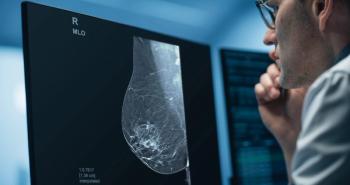
Breast Density and Radiation Dose in Mammography
Effect of breast density on mammography radiation dose.
Breast density has only a minor impact on radiation dose during mammography examinations, according to a study published in
Researchers from the University of Virginia Health System in Charlottesville, performed a retrospective study to evaluate the relative contribution of breast density to the radiation dose from screening mammography.
The researchers collected patient age, weight, height, compressed breast thickness, and average glandular dose for each exposure for 434 sequential patients undergoing screening mammography. The median age of the patients was 58 and they had a median body mass index of 26.8. Median volumetric breast density was 5.8%, ranging from 1.7% to 30.5%.
The results showed that the median compressed breast thickness was 63.4 mm, ranging from 24.5 mm to 111.5 mm. Univariate analysis showed positive associations between radiation dose and both breast thickness and BMI, an inverse association with age, and no association with density. Multivariate regression analysis demonstrated a significant association between dose and age, laterality, BMI, density, and breast thickness.
There was larger overall attenuation with larger breast thickness, but the system automatic exposure control balanced this out by selecting a higher tube voltage (kVp) and/or current-time product settings.
The researchers determined that it was breast thickness that was the primary determinant of dose, accounting for 76% of the 58% of the dose variability, followed by density (8%), laterality (4%), age (less than 1%), and BMI (less than 1%). Compressed breast thickness had the greatest effect on average glandular dose. Breast density has a minor impact, while BMI and age have minimal impact on dose.
Newsletter
Stay at the forefront of radiology with the Diagnostic Imaging newsletter, delivering the latest news, clinical insights, and imaging advancements for today’s radiologists.




























